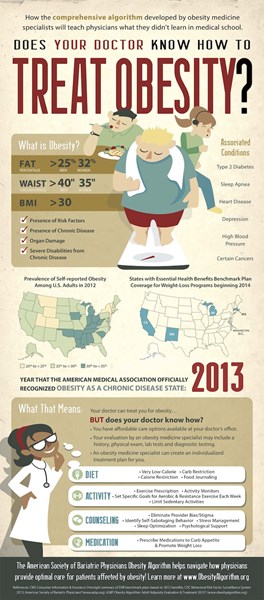DENVER, Oct. 11, 2013 (GLOBE NEWSWIRE) -- Today, the American Society of Bariatric Physicians (ASBP) rolls out the first-ever comprehensive algorithm that navigates the physician's role in medically treating and caring for patients affected by obesity.
The ASBP Obesity Algorithm—developed and written for the Society by a group of leading obesity medicine specialists—aims to give all physicians training and tools for prescribing and implementing obesity treatment plans for patients. Among these plans, changes in nutrition, exercise and behavior are included. Physicians may also recommend weight-loss medications or discuss surgical options for excess fat reduction.
The ASBP Obesity Algorithm will be available as a free download from www.ObesityAlgorithm.org after 6 p.m. (PT) tonight, and a video podcast about how physicians can use the algorithm will be available on Oct. 13 from the site.
"Physicians are now confronted with the need to understand what makes obesity a disease and how patients affected by obesity are best managed," said ASBP President-elect and Algorithm Committee Co-chair Deborah Bade Horn, D.O., M.P.H., F.A.S.B.P. "They can benefit from the algorithm, which compiles the experience of researchers and clinicians who engage in obesity treatment on a day-to-day basis."
The algorithm emphasizes patients' overall health and reduction in risk of developing associated conditions, such as type 2 diabetes, hypertension, sleep apnea, cardiovascular disease and depression. Changes will only be recommended following an examination of the patient's current lifestyle, family history, physical exam and laboratory testing. The algorithm will aid physicians in determining whether these results warrant a need for intervening obesity treatment and what that care would look like.
The algorithm also offers suggestions for affordable treatment options. Physicians can use the algorithm to create individualized treatment plans for patients, providing them with optimal obesity care at an affordable cost.
"This will help give physicians a better opportunity to manage patients affected by obesity in the most compassionate, scientifically sound and cost-effective way possible," said ASBP Trustee and Algorithm Committee Co-chair Jennifer Seger, M.D.
Following the American Medical Association's (AMA's) decision in June to declare obesity a chronic disease state, more patients are seeking treatment options from their primary care providers. However, research studies indicate that primary care physicians want and need more help in discussing obesity with their patients. According to a study published in December 2012, primary care physicians have a perceivable need for additional education and training in order to improve treatment and care for patients affected by obesity. The U.S. Centers for Disease Control and Prevention reports that nearly 36 percent of U.S. adults and 17 percent of youth are affected by obesity. Obesity increases the risk of having heart disease, stroke, type 2 diabetes, and certain cancers, the leading causes of preventable death in the United States.
The American Society of Bariatric Physicians (www.asbp.org) is the leading association for clinical physicians and other providers dedicated to the comprehensive medical treatment of patients affected by obesity and associated conditions. Many ASBP-member physicians also hold certification from the American Board of Obesity Medicine. Physicians may download a free copy of the ASBP Obesity Algorithm at www.ObesityAlgorithm.org. Individuals can search for obesity medicine specialists in their own area at www.FindObesityTreatment.org.
Note to the Editor: Members of the media can download an advanced copy of the ASBP Obesity Algorithm, a summary about how physicians can use the algorithm, the Medical Obesity Treatment Options Fact Sheet, and a patient-friendly infographic. Contact heidi@asbp.org to make requests for interviews.
A photo accompanying this release is available at: http://www.globenewswire.com/newsroom/prs/?pkgid=21503
